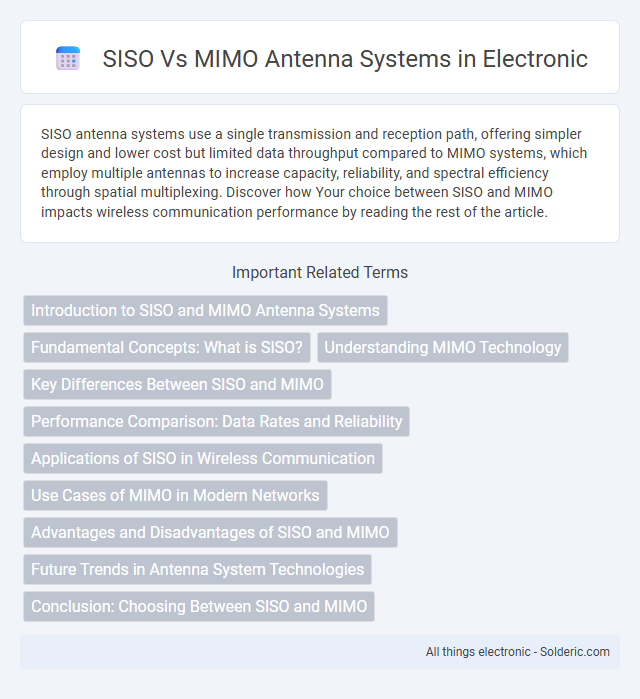SISO antenna systems use a single transmission and reception path, offering simpler design and lower cost but limited data throughput compared to MIMO systems, which employ multiple antennas to increase capacity, reliability, and spectral efficiency through spatial multiplexing. Discover how Your choice between SISO and MIMO impacts wireless communication performance by reading the rest of the article.
Comparison Table
| Feature | SISO (Single Input Single Output) | MIMO (Multiple Input Multiple Output) |
|---|---|---|
| Definition | Single antenna for transmission and reception | Multiple antennas for transmission and reception |
| Data Throughput | Lower, limited by single data stream | Higher, supports multiple simultaneous data streams |
| Spectral Efficiency | Low | High, increases channel capacity |
| Signal Reliability | Lower, prone to fading and interference | Higher, uses spatial diversity to reduce errors |
| Complexity | Simple hardware and signal processing | Complex hardware and advanced signal processing |
| Cost | Lower cost | Higher cost due to multiple antennas and processing |
| Use Cases | Basic wireless communication, legacy systems | Modern WiFi, LTE, 5G for enhanced performance |
Introduction to SISO and MIMO Antenna Systems
SISO (Single Input Single Output) antenna systems use one antenna at both the transmitter and receiver ends, offering simpler design and lower cost but limited capacity and data rates. MIMO (Multiple Input Multiple Output) employs multiple antennas at both ends to enhance throughput, reliability, and spectral efficiency by exploiting spatial multiplexing and diversity. Understanding these fundamental differences helps you optimize wireless communication performance for various applications and environments.
Fundamental Concepts: What is SISO?
SISO (Single Input Single Output) refers to a basic antenna system where one transmitter and one receiver antenna are used, transmitting and receiving a single data stream. This system relies on a single communication channel, making it simpler but less efficient in handling multipath and spatial diversity compared to MIMO (Multiple Input Multiple Output). Understanding SISO fundamentals helps you evaluate its limitations in capacity and reliability compared to advanced antenna technologies.
Understanding MIMO Technology
MIMO (Multiple Input Multiple Output) technology utilizes multiple antennas at both the transmitter and receiver ends to significantly enhance wireless communication performance by increasing data throughput and signal reliability. Compared to SISO (Single Input Single Output) systems, MIMO leverages spatial multiplexing and diversity techniques, enabling simultaneous transmission of multiple data streams and improved resistance to multipath fading. This results in higher spectral efficiency and more robust connections, particularly in complex wireless environments.
Key Differences Between SISO and MIMO
SISO (Single Input Single Output) antenna systems use one antenna at both the transmitter and receiver ends, limiting capacity and data rates, while MIMO (Multiple Input Multiple Output) employs multiple antennas at both ends to enhance signal quality and increase throughput. MIMO exploits spatial diversity and multiplexing to improve spectral efficiency and reliability in wireless communication. The key differences between SISO and MIMO include antenna configuration, data transmission techniques, and performance gains in terms of capacity, range, and interference mitigation.
Performance Comparison: Data Rates and Reliability
MIMO antenna systems significantly outperform SISO systems by offering higher data rates through multiple spatial streams, enhancing your wireless communication capacity. The use of multiple antennas in MIMO improves signal reliability and reduces error rates by exploiting spatial diversity and multipath propagation. Consequently, MIMO systems provide superior performance for high-throughput applications and maintain stable connections in challenging environments compared to SISO technology.
Applications of SISO in Wireless Communication
SISO antenna systems are widely used in simple wireless communication devices such as cordless phones, Bluetooth headsets, and early Wi-Fi routers due to their low complexity and cost-effectiveness. Your home Wi-Fi network or basic cellular connections can efficiently operate with SISO technology where limited data rates and coverage are sufficient. These systems are optimal for environments with minimal interference and when power consumption needs to be minimized.
Use Cases of MIMO in Modern Networks
MIMO (Multiple Input Multiple Output) antenna systems are essential in modern networks for enhancing data throughput and spectral efficiency, especially in 4G LTE and 5G NR technologies where they enable high-speed mobile broadband and reliable connectivity. Your device benefits from MIMO's ability to support simultaneous data streams, improving performance in congested urban environments and supporting applications such as video streaming, online gaming, and virtual reality. By contrast, SISO (Single Input Single Output) is limited to single data streams, making it less effective in meeting the demands of current high-capacity wireless communications.
Advantages and Disadvantages of SISO and MIMO
SISO antenna systems offer simplicity and lower cost with easier implementation in single-stream communication but suffer from limited data rates and reduced reliability in multipath environments. MIMO antenna systems leverage multiple antennas at both transmitter and receiver ends, enhancing spectral efficiency, data throughput, and signal robustness through spatial multiplexing and diversity gains. However, MIMO systems are more complex, require sophisticated signal processing, and incur higher power consumption and hardware costs.
Future Trends in Antenna System Technologies
Future trends in antenna system technologies emphasize the shift from traditional SISO (Single Input Single Output) to advanced MIMO (Multiple Input Multiple Output) systems, leveraging multiple antennas to enhance data throughput and reliability in 5G and beyond. MIMO's ability to exploit spatial multiplexing and beamforming techniques significantly improves spectral efficiency and network capacity, paving the way for ultra-reliable low-latency communications and massive IoT connectivity. Your wireless applications will benefit from these innovations, enabling faster, more robust, and scalable communication networks essential for smart cities and next-generation mobile devices.
Conclusion: Choosing Between SISO and MIMO
Choosing between SISO and MIMO antenna systems depends on your specific wireless communication needs and environment. MIMO systems offer higher data rates, improved signal reliability, and better spectral efficiency by using multiple antennas simultaneously, making them ideal for high-density or interference-prone areas. SISO systems provide simplicity and lower cost, suitable for basic applications with limited bandwidth and less complex channel conditions.
SISO vs MIMO antenna systems Infographic

 solderic.com
solderic.com